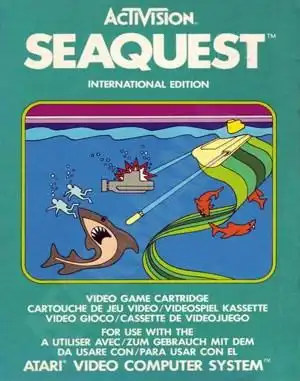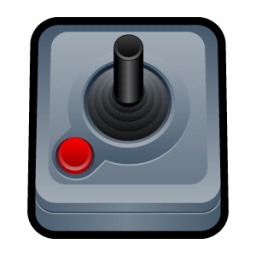Remember the satisfying thunk of inserting an Atari 2600 cartridge? For many of us, one particular cart promised tense underwater adventure: Seaquest Atari 2600. This wasn't just another shoot-'em-up; it was a frantic ballet of rescue, resource management, and dodging deadly pixelated sea creatures in the deep blue (or sometimes black) pixel sea.
Released by Activision in 1983, Seaquest plunged players into the role of a lone submarine captain tasked with a vital, albeit dangerous, mission: saving stranded divers while fending off an increasingly aggressive marine ecosystem and enemy subs. It combined fast reflexes with a surprising layer of strategy, making it a standout title in the Atari 2600's vast library.
Diving into the Deep: Gameplay Basics
At its core, Seaquest is about survival and rescue. You control a small, nimble submarine navigating horizontally across a side-scrolling underwater environment. The primary goal? To locate and collect the hapless divers floating near the surface.
But the ocean is a dangerous place! Sharks and enemy submarines patrol the waters, and a single collision means the loss of one of your precious reserve subs. Thankfully, you're armed with unlimited torpedoes fired with the joystick button. Blasting enemies earns points, but the real score comes from successful rescues.
You can carry up to six divers at a time. Once your sub is full (or if oxygen is critically low), it's time to make a risky dash for the surface.
The Oxygen Gamble: Managing Your Air Supply
One of the most crucial mechanics in Seaquest Atari 2600 is oxygen. Your sub has a limited air supply, constantly ticking down while you're submerged. A handy gauge at the top of the screen shows your remaining time.
When the oxygen gets low, an alarm blares, adding to the tension. If you run out of air before surfacing, you lose a sub! To refill your oxygen, you must ascend to the surface.
Here's where the strategy kicks in:
- Surfacing with a full load of six divers earns you big bonus points.
- Surfacing with fewer than six divers incurs a penalty.
- Surfacing just to get air, without any divers, is the harshest penalty – you lose a sub!
This creates a constant push-and-pull: stay down longer to find more divers for a better score, or surface early to avoid running out of air and losing a life?
The Increasing Pressure: Difficulty and the Patrol Sub
Like many classic arcade-style games, Seaquest gets progressively harder. After each successful surfacing with divers, the enemies become faster and more numerous. Those slow-moving sharks and subs from the early stages turn into relentless, high-speed threats.
Then, after you've rescued a certain number of divers (typically 12), a new, more dangerous foe appears: the Enemy Patrol Sub. This large, imposing vessel guards the surface, making your essential trips for air far more perilous. You can't destroy it; you just have to avoid it while you quickly refill your oxygen before diving back down. Navigating around this behemoth while enemies swarm below adds a significant challenge to later stages.
Scoring Big and Joining the Club
Points are awarded for shooting enemies and, most importantly, for rescuing divers. The value of rescued divers increases with each successful return trip to the surface. Mastering the balance between clearing threats and maximizing diver rescues is key to high scores.
Back in the day, achieving a truly impressive score (50,000 points or more) in Seaquest Atari 2600 wasn't just for bragging rights among friends. Players could snap a photo of their high score screen and send it to Activision to join the exclusive "Seaquest Sub Club" and receive a special patch. Talk about retro gamer cred!
Why Seaquest Still Holds Water
Seaquest wasn't the most graphically complex game on the 2600, but its genius lay in its simple yet effective blend of mechanics. It took the core idea of a shooter and added objectives beyond just blasting everything. The diver rescue added a strategic layer and a sense of purpose, while the oxygen meter created a constant, high-stakes timer that forced tough decisions.
It's a game that's easy to pick up but difficult to master, demanding both quick reflexes for dodging and shooting, and forward thinking for managing your oxygen and knowing when to surface. This solid design is why many retro enthusiasts still rank Seaquest highly among the Atari 2600's library.
Playing Seaquest Today
Feeling nostalgic and want to take the plunge back into Seaquest? While finding a working Atari 2600 and cartridge might be a treasure hunt in itself, there are easier ways to experience this classic today:
- Emulators: Software like Stella allows you to play Atari 2600 ROMs on modern computers.
- Online Archives: Websites like the Internet Archive have libraries of classic games, often playable directly in your browser using Javascript emulators. Search for "Seaquest Atari 2600" there.
- Compilation Packs: Occasionally, classic Atari games appear in modern collections on platforms like Steam, GOG, or console online stores, though availability varies.
However you play it, the core challenge and addictive loop of Seaquest remain intact.
Quick Dive: Seaquest Atari 2600 FAQ
Q: What is the main objective in Seaquest Atari 2600? A: To rescue stranded divers by collecting them with your submarine and returning them to the surface, while avoiding or destroying enemy sharks and subs.
Q: How do you refill oxygen in Seaquest? A: You must ascend your submarine to the surface of the water to automatically refill your oxygen gauge.
Q: How many divers can you carry at once? A: Your submarine can hold a maximum of six divers at a time.
Q: What was the "Sub Club"? A: The Sub Club was a special achievement program run by Activision where players who achieved a score of 50,000 points or more in Seaquest could send in proof to receive an exclusive patch.
Whether you're revisiting a childhood favorite or discovering it for the first time, Seaquest Atari 2600 offers a compelling mix of action and strategy that still holds up. So, fire up an emulator, grab your (virtual) joystick, and get ready to dive deep!


